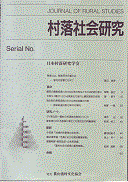The purpose of this article is to clarify the logic and inevitability of Japanese landownership in Manchuria and the peculiarity of the farming immigrants in this northeastern region of China by analyzing the management of the Mizuho Village by the third experimental group and the realities and logic of the farmers’ behaviors in their life.
It was demanded that immigrant farmers conduct diversified farm operations and lead a self-sufficient life in order to provide for themselves production and living means.
The fact, however, was contrary to the aforementioned political demand. The villagers were forced to expend excessive cash. At the same time, their produce were differentiated as cash crops. This led them to employ many local laborers for farm management and they were obliged to purchase daily necessities and some other things to survive.
On the other hand, differentiation of farm products led to a steep rise in wages. In the face of wage increases prevailing in the Manchurian farm villages as a whole, Japanese immigrant farmers were driven into a corner to the point of bankruptcy. They had no other choice but to spoil their farmland in order to keep local labor to a minimum and become landowners. Nevertheless, weeding was insufficient on their own farmland, and as a result, their yield began to drop on both their paddies and farms. It accelerated instability in farm management conducted by them. Consequently landownership was sought after in an attempt to disperse farm management risks.
Whatever efforts they made, the end result was the devastation of fertile farm land due to extensive, careless agriculture, followed by landownership on the part of them. In addition, this fact illustrates their resource-depriving and non-continuous farm management. Herein lies a difference with Japanese farmers, that is, the non-farmer characteristic of the Japanese immigrants.
抄録全体を表示
